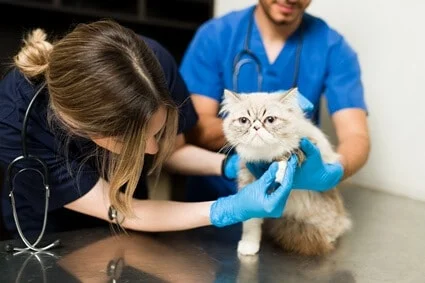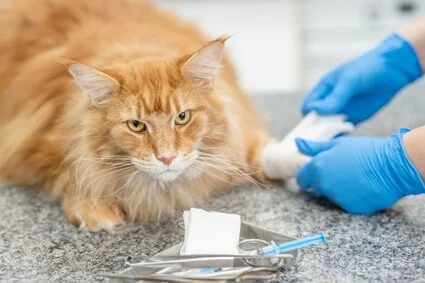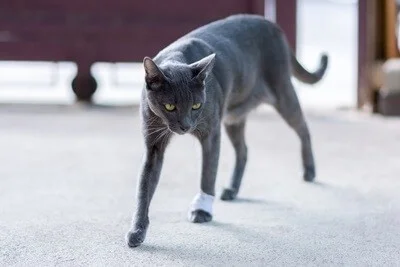Cats never limp without a good reason. Even if your cat is not crying, don’t assume that it’s not masking its discomfort. Some cats become accustomed to pain and no longer react.
Common reasons for a limping cat include trauma, arthritis, and infection. Some senior cats overexert themselves while exercising, causing temporary lameness. Your cat could have an issue with its paw due to plant or insect stings, a trapped foreign object, overgrown nails, or a skeletal defect.
If your cat is limping, check for signs of pain. These aren’t restricted to verbalizations, such as crying. Regardless of whether your cat is in discomfort, you need to address the cause of the limping.
Why is My Cat Limping but Not in Pain?
There is a high probability that your cat is in pain, but it doesn’t want you to know. According to The Journal of Feline Medicine and Surgery, cats are skilled at masking the signs of discomfort.
Pain equates to vulnerability, and showing weakness means conceding territory to a rival feline. As a result, your cat may not let you know that it’s in discomfort.
Beyond verbalizing, signs of pain include:
- Hiding away
- Uncharacteristic aggression
- Refusing physical contact
- Reluctance to move or to reveal a limp
- Lack of grooming
- Hunching over
- Lack of appetite
A cat in pain may also purr more. Comparative and Veterinary Pharmacology discusses how cats purr to cope with discomfort. The vibrations created by purring provide relief to a cat.
Here are the main causes of limping in cats:
Arthritis
Cats of any age can develop arthritis, but it’s most prevalent among older felines.
The first sign of arthritis is less physical activity due to weak back legs. Your cat will exercise less and lose interest in playing. It’ll be easy to dismiss this as just old age, but your cat finds activity difficult.
How a cat reacts depends on how painful arthritis is. For most cats, arthritis is a condition that slowly escalates, and it learns to hide the symptoms. That’s why you have to check for behavioral changes.
While there is no cure for arthritis, a vet can prescribe painkillers, but this isn’t a long-term solution.
Arthritis is treated with non-steroidal anti-inflammatory drugs (NSAIDs). However, NSAIDs aren’t approved for prolonged use on animals in the United States.
Focus on making your cat more comfortable with:
- Soft bed with padding
- Direct heat source application
- Supplements from a pet store
- Massages for your cat’s joints
- Low-sided litter trays
Encourage regular exercise to keep the joints supple, but allow the cat to dictate the pace and allow time for resting.
Broken Bones
If your cat is limping, you may fear that it has a broken bone. Cats experience broken bones due to impact injuries, perhaps due to road traffic accidents or falling from a height.
Check the leg in question. Just because a bone is not protruding, it doesn’t mean that it isn’t broken. The cat may have a minor fracture.
Check for the following symptoms:
- Leg hanging loose
- Rapid breathing
- Swelling around the leg
- Signs of shock
The only way to be certain is with an x-ray. Cats can slowly self-heal a broken leg, but the bones may grow back misaligned, prolonging the limping.
Nerve Damage
If your cat had an impact injury, it may have also sustained nerve damage. For example, injuries to the spine can cause hind leg paralysis.
Damage to the nerves affects a cat’s quality of life. Without the ability to move the back legs, cats cannot eliminate, run, or climb. According to Veterinary Surgery, sciatic nerve damage often requires surgery to treat.
Soft Tissue Injuries
Soft tissue injuries are sprains and tears to a cat’s muscles. The same issues as broken bones can cause soft tissue injuries, along with moving too quickly or taking a bad step.
A soft tissue injury can often be resolved with rest. If the cat stays off its feet for a few days/weeks, it may show signs of recovery. Offer your cat a soft bed or cushions, and apply ice to the site of the injury to reduce swelling.
Cats with uncomfortable soft tissue injuries shouldn’t be allowed to climb or jump down from high places. If your cat is restless, keep it in a large pet carrier.
A cat may need a splint and/or physiotherapy to manage a muscular injury in more severe cases.
Paw And Paw Pads Issues
If a cat’s paw pads are swollen, blistered, or bleeding, it will limp but no cry to hide its pain.
Common reasons why cats experience sore paw pads include:
- Cuts and scrapes
- Burns from hot pavement or asphalt
- Time spent in a cage

Feline Plasma Cell Pododermatitis (Pillow Foot)
Feline plasma cell pododermatitis affects a cat’s paw pads. According to Veterinary Dermatology, the symptoms include swelling, lesions, and abscesses on the feet. This condition will make it awkward for your cat to walk.
Cyclosporine (Atopica) and Doxycycline are often used to treat this condition. Surgery is rarely required. However, if necessary, ulcers will need to be removed with a scalpel.
Insect Bites or Stings
Your cat may have been stung on the paw due to accidentally stepping on a bee or wasp. The area may swell, and walking will likely be more difficult.
Other insects may sting or bite your cat’s paws. Fire ants are small, but their bite is excruciating. Certain breeds of spiders will cause a cat’s paw to swell up and result in limping.
Plant Stings
If your cat steps on stinging nettles, its paws will feel uncomfortable due to skin irritation and swelling. Your cat will quickly recover, but it may limp for up to 24 hours.
Foreign Objects in Paw Pads
If a cat gets a stone trapped between its paw pads, it’ll find it harder to walk.
Inspect your cat’s paw pads. If you spot a foreign object, such as a splinter, gently remove it with tweezers. Remove any foreign objects with tweezers to prevent them from embedding more deeply.
Clean and sterilize the wound with an antibacterial cream, such as Neosporin.
Overgrown Claws
Clipping the claws is essential. If your cat’s claws become overgrown, they’ll curl inward, making walking difficult.
As cats age, blunting their claws becomes more difficult as they get less exercise. Consequently, older cats rely on their owners for nail maintenance.
Diabetes
If a cat’s diabetic, it’ll experience neuropathy, which is numbness in a cat’s limbs. Acta Neuropathologica compares this to human diabetes and the associated loss of feeling in the feet.
If a cat has diabetic neuropathy, it’ll struggle to walk, which is usually a late-stage symptom of diabetes.
Check for these warning signs of diabetes:
- Excessive thirst
- Increased urination
- Weight loss despite enhanced appetite
- Lethargy
- Vomiting
Diabetic neuropathy causes permanent nerve damage. However, by controlling your cat’s diabetes, you can prevent the condition from getting any worse.
If your cat is overweight, this will adversely affect its gait as additional weight will be applied to the joints.
Bacterial or Fungal Infection
Abscesses are a common cause of feline bacterial infections that result in lameness. These are most common in outdoor cats due to bite wounds and punctured skin due to fighting.
An abscess is essentially a ball of pus that will swell on a cat’s skin. A vet will drain this pus using a syringe.
Feline Calicivirus (FCV)
Feline calicivirus is an upper respiratory infection.
FCV causes swelling and arthritis in a cat’s joints. If your cat is arthritic, you may overlook this development. As explained by Veterinary Microbiology, kittens are likelier to experience lameness than senior cats.
FCV is treated using antibiotics. Older cats could face more complications due to limited immunity. The main risk of FCV is a secondary infection, such as gum disease.
Bartonella Henselae (Cat Scratch Disease)
Cats often have Bartonella henselae without you realizing it. Most owners discover that their cat has Bartonella henselae when it scratches you because the site of the scratch will swell and itch.
While Bartonella henselae is often symptomless in cats, offshoots of the condition are less so. As The Journal of Feline Medicine and Surgery explains, Bartonella vinsonii can cause stiffness and lameness. The infection can lead to osteomyelitis, which is a bone infection.
Bartonella henselae and associated illnesses are treated with antibiotics for 6 weeks.
Coccidioidomycosis (Valley Fever)
Coccidioidomycosis is a fungal skin disease that can impact cats. The fungal spores live in the soil, which means that outdoor cats that dig are most likely to be affected by this condition.
Coccidioidomycosis starts with difficulty breathing, coughing, and a fever. From here, the disease causes swelling in the bones and joints. This can leave a cat limping as it will be difficult to move the hind legs.
Coccidioidomycosis requires lifelong treatment with oral antifungal medications.

Parasites
Parasitic infestations can cause stiffness and lameness in cats. For example, flea bites can cause localized swelling.
Be mindful of bites from ticks, especially if you live in the Northeast, as limping and lameness can be signs of Lyme disease.
Heartworm
If a mosquito bites your cat, heartworm larva may enter the blood. From here, it’ll live in a cat’s heart and lungs. Lameness and limping are the only visible symptoms of heartworm, occurring when it migrates to the legs.
Heartworm in cats is rare as their bodies are inhospitable environments. Most heartworm die inside a cat’s body before reaching adulthood and will be shed through feces.
Musculoskeletal Issues
A limp can be due to a musculoskeletal issue, and if this is hereditary, you’ll discover it early in life. A bone problem can also occur later in life due to hip dysplasia.
A ball and socket connect a cat’s hips. As your cat ages, these two body parts can become increasingly misaligned, which eventually means that your cat struggles to walk properly.
Hip dysplasia is more common in heavy-boned cats, such as Maine Coons or Persians. Female cats are likelier to develop the problem than males. Veterinary Radiology and Ultrasound found 12 impacted purebred breeds.
Other than limping, signs that a cat has hip dysplasia include:
- Wasting of leg muscles
- Holding legs close together
- Enhanced shoulder muscles
The lighter the cat, the likelier the displacement can be treated as an outpatient. If necessary, your cat will undergo a hip replacement.
Fibrotic Myopathy
Fibrotic myopathy is a condition that causes sudden-onset lameness in the rear legs, resulting in an irregular gait and limp. The leg muscles waste away and are replaced by scar tissue.
Fibrotic myopathy is likely to be a lifelong issue. The Journal of the American Medical Veterinary Association and The Journal of Small Animal Practice have profiled cases where the condition was initially treated with surgery but returned.
A limping cat may be hiding pain, so don’t rely on a cat coming to you for assistance. Given the number of causes of limping in cats, it’s advisable to book a consultation with a veterinarian.

